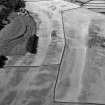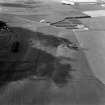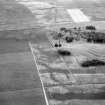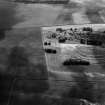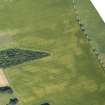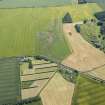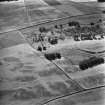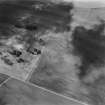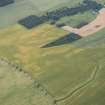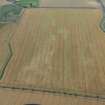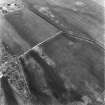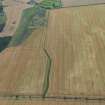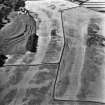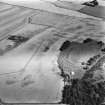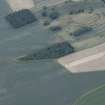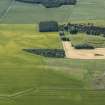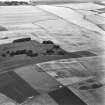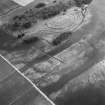The Chesters, Drem
Pit Alignment(S) (Prehistoric)
Site Name The Chesters, Drem
Classification Pit Alignment(S) (Prehistoric)
Alternative Name(s) Foster Law
Canmore ID 56323
Site Number NT57NW 49
NGR NT 50991 78570
NGR Description From NT 5098 7831 to NT 5096 7876
Datum OSGB36 - NGR
Permalink http://canmore.org.uk/site/56323
- Council East Lothian
- Parish Athelstaneford
- Former Region Lothian
- Former District East Lothian
- Former County East Lothian
NT57NW 49 5098 7831 to 5096 7876
See also NT57NW 1, NT57NW 47, NT57NW 51, NT57NW 65, NT57NW 114.
Scheduled (with NT57NW 41 and NT57NW 49 ) as Foster Law, pit alignment.
Information from Historic Scotland, scheduling document dated 16 December 1993.
The cropmarks of a closely spaced alignment of pits have been identified from aerial photographs to the W of The Chesters fort (NT57NW 1) and 350m WNW of Dalvreck farmsteading. The alignment runs in an N-S direction and is visible for about 470m from NT c.5098 7831 (adjacent to The Chesters) to NT c.5096 7876. The S half of the alignment is sinuous, whilst the more regular N half has only been recorded on recent aerial photographs (RCAHMSAP 1995). A series of pit-alignments has been recorded around The Chesters including NT57NW 46 and NT57NW 50 -52 and 114.
Information from RCAHMS (KB) 15 December 1999
Project (September 2012)
NT 504 782 – NT 506 784 (approx) The Chesters, Drem (SAM 90072) is one of the best preserved Iron Age hillforts in Scotland and is protected both by scheduling and as a PIC. However, the upstanding remains form just one element of an extensive Iron Age landscape evidenced by cropmarks identified through many years of aerial survey. Most notably, these comprise an extensive series of pit alignments which appear to reflect a cohesive system of land division potentially extending up to 5km2, and reaching as far as neighbouring hillforts at Kae Heughs (NT57NW 23) and Hanging Craig (NT57NW 89). Our project involves geophysical evaluation of these landscapes using a range of integrated and complementary techniques including standard fluxgate gradiometry and earth resistance survey. We also trialled two novel techniques currently under development and not previously used to any extent in Scotland: electrical resistivity tomography and electromagnetic survey. Gradiometry was used as the baseline technique to recover broad scale information and give wide coverage across the sites, with other techniques being used in targeted areas based on initial results and detailed field inspection.
Results from work in September 2012 were generally positive and identified the cropmark features in most areas. Several new features have been identified, including at least one probable barrow, but more significant perhaps is the new data retrieved relating to the micro-topography of the pit alignment systems and the detailed relationships between these archaeological features and the local geology.
Archive: RCAHMS (intended). Reports: East Lothian SMR and RCAHMS (intended)
Funder: Historic Scotland
Ian Armit, University of Bradford
Chris Gaffney,
Tom Sparrow,
Finn Pope-Carter,
2012
Magnetometry (September 2012)
NT 504 782 – NT 506 784 (approx) The Chesters, Drem (SAM 90072) Fluxgate gradiometry was used to investigate this extensive Iron Age landscape.
Archive: RCAHMS (intended). Reports: East Lothian SMR and RCAHMS (intended)
Funder: Historic Scotland
Ian Armit, University of Bradford
Chris Gaffney,
Tom Sparrow,
Finn Pope-Carter,
2012
Electromagnetic (September 2012)
NT 504 782 – NT 506 784 (approx) The Chesters, Drem (SAM 90072) Electromagnetic survey techniques were used to investigate this extensive Iron Age landscape.
Archive: RCAHMS (intended). Reports: East Lothian SMR and RCAHMS (intended)
Funder: Historic Scotland
Ian Armit, University of Bradford
Chris Gaffney,
Tom Sparrow,
Finn Pope-Carter,
2012
Electrical Resistivity Tomography (September 2012)
NT 504 782 – NT 506 784 (approx) The Chesters, Drem (SAM 90072) Earth resistance survey and electrical resistivity tomography techniques were used to investigate this extensive Iron Age landscape.
Archive: RCAHMS (intended). Reports: East Lothian SMR and RCAHMS (intended)
Funder: Historic Scotland
Ian Armit, University of Bradford
Chris Gaffney,
Tom Sparrow,
Finn Pope-Carter,
2012
Aerial Photographic Transcription (7 June 2019)
An interpretative transcription, or mapping, of information on oblique aerial photographs was produced on 7 June 2019.
Note (27 September 2022)
The location, classification and period of this site have been reviewed.
























































